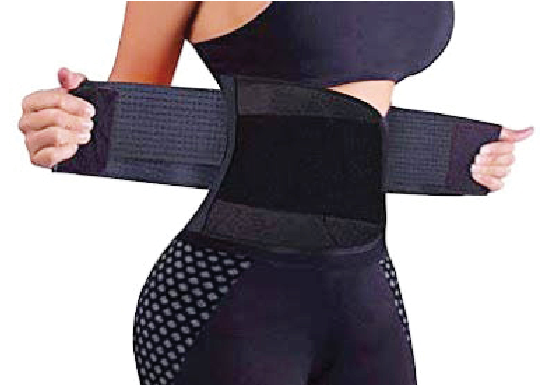Whether on social media or being touted by celebrities, chances are you’ve probably seen waist trainers somewhere on the internet lately. They’re those corset-like garments that supposedly give you an hourglass shape over time.
While they may be trendy, they’re not likely to help you lose much weight around your middle. In fact, they can be dangerous and may be risky to your health.
Wearing a waist trainer has numerous benefits for your health and emotional well-being, but if you wear your waist trainer 365 days a year, there are certain side effects that can also happen
Waist trainers are made of a thick elastic fabric, like neoprene. They’re meant to be worn snugly around your midsection, the back often has laces, Velcro, or hooks.
Some people compare waist trainers to shapewear, but there’s one huge difference: waist trainers are meant to be worn regularly and even tightened over time.
Because of that, some people claim they can help you lose weight and get more of an hourglass figure. Some companies that sell waist trainers also recommend wearing one after having a baby.
So can they really help you lose weight? Not exactly. Instead, there are three main things happening:
*Squeezing
Waist trainers squeeze your midsection, kind of like super-intense shapewear. But the effect disappears as soon as you take the trainer off.
*Sweating.
You might sweat more than usual while wearing a waist trainer (they’re hot!), which can make you lose water weight. But this effect is temporary.
*Shrinking
If you wear a waist trainer consistently, your core muscles can atrophy and shrink from lack of use. Since your stomach is squeezed, you’re also less likely to overeat while wearing one.
All of these changes could make you look and feel slimmer without actually helping you lose any weight.
Aside from discomfort, waist trainers pose some pretty serious health risks, they include,
- Heart Problems
Due to being rather restricting, a waist trainer can lead to problems with blood circulations, which, in turn, will cause your heart to work harder with negative consequences.
- Digestive Problems
Most waist trainer feel rather tight on your abdomen and often compress your stomach, intestines, and colon. As a result, you may experience heartburn and other problems with your digestion.
- Bladder Pressure
If you have ever worn a waist trainer for an extended period of time, you know that going to the bathroom in a girdle can be rather uncomfortable. As a result, women keep from relieving their bladder on time, which, over time, can lead to incontinence and leakage.
- Breathing Problems
Wearing a waist trainer makes it harder to breathe
Breathing deep is an essential requirement for the normal operation of every system in our bodies. Wearing a tight girdle constrains your diaphragm, making your stomach flare up when you are breathing, which results in shallow breaths.
5.Varicose Veins
If you are genetically predisposed to the varicose vein problem and have multiple women in your family suffering from the disease, there is a big chance that wearing a girdle every day will make the blood circulation in your legs worse and lead to the formation of varicose veins.
- Weakened core
Waist trainers provide support that would normally come from your core muscles. If you wear a waist trainer but don’t train your core, you could end up with severely weakened abdominal muscles.
Weak abs can ultimately lead to poor posture and back pain.
- Weakened pelvic floor
After giving birth, your pelvic floor muscles and the surrounding organs need time to heal. If you wear a waist trainer while healing, it can make matters worse instead of better. That’s because the trainer will put additional pressure on your pelvic floor.
While this damage isn’t always visible, it can lead to incontinence or prolapse.
- Rashes and infections
Waist trainers are often made from synthetic fabrics and are meant to be worn tightly. They tend to keep moisture — like sweat — in instead of allowing it to evaporate off your skin. This can cause irritation, leading to rashes and even bacterial and yeast
How To Limit Risk
If you’re still interested in wearing a waist trainer, there are ways to limit your risk of complications.
For example, you could try saving your waist trainer for special occasions — like under your clothes on a night out or as part of a costume.
Even so, make sure you’re wearing the trainer loosely enough that you can take a breathe and move without feeling too restricted. If you start to feel dizzy or short of breath, take it off immediately.
Safer Alternatives
If you’re looking for a safer short-term solution, you might want to opt for shapewear instead of a waist trainer. It’ll give you a similar look to a trainer with less risk to your health.
If you’re more interested in a long-term weight-loss solution, exercise and a healthy diet are your best bets. Here are some tips for getting started:
*Reach for natural, unprocessed foods.
*Avoid sugary and processed food products.
*Keep an eye on portion sizes.
*Set small but feasible exercise goals, like taking a short walk each day.
*Burn calories with aerobic exercise.
*Use strength training to tone your muscles.
Waist trainers pose a variety of health risks, and their benefits are unproven.
Opt for safer alternatives to trimming your midsection, like a balanced diet and regular exercise.
We’ve got the edge. Get real-time reports, breaking scoops, and exclusive angles delivered straight to your phone. Don’t settle for stale news. Join LEADERSHIP NEWS on WhatsApp for 24/7 updates →
Join Our WhatsApp Channel










